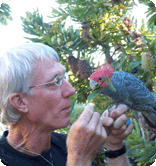Nesting African Grey Parrots

My Question: have 8 rescue Greys in a large outdoor aviary. All get on very well, and two pairs are very bonded. to encourage breeding, what shape should nest boxes be, what nesting materials are needed and how does mating take place - we had a pair in an existing nest box yesterday, for two pairs, who seemed to be mating. Thank you.
Bettina Hickman

Dear Bettina, The short answer to your question is we would offer African greys a nesting box out of thick wood (not metal or plastic!) which was 8 inches by 10 inches interior floor size, 30 inches tall, 4 to 5 inch round opening at the top under a large overhanging roof board. It needs to be facing a private area so the hen and cock do not always have to be looking out of their box and seeing other greys interested. Food and water should be near at hand so the pair does not have to compete for nourishment or choose to eat and drink less because they do not want to leave their egg clutch and venture far.
Inside we place coarse wood chips (not sawdust) and a few chunks of bark and rotting log material for them to chew up, also a small green bough of eucalyptus, rosemary, etc. to deter bugs. Depth of chips is four inches to start, then they add to it usually by chewing.
The longer answer to your question would be “why are you breeding African greys” at all. As can be seen from your eight rescue Greys, there are so very many unwanted parrots of all kinds out there, and sometimes it seems best not to bring more babies into the world where good ‘forever’ homes are increasingly hard to find…
Do you have a plan for the chicks you might get? Is the space they are kept in large enough for three, four, six or more extra Greys? Are you making a decision to breed to sell or adopt out? How old are you and your family, and is everyone committed to long term care for the young parrots?
Now, I am not trying to be negative here. There are some fine ethical reasons for permitting a pair of African greys that wish to become sexual and have a family, go ahead and do so. But it can become complicated, certainly in a colony situation where all birds are not firmly bonded and paired up. In the wilds we know that greys nest in “communal” types of situations—but captive parrots can have issues about territory and baby noises coming from a box and extra food treats (pairs with babies being fed need four or five times the food that everyone else gets and it often needs to be special, i.e. premium greens, extra nuts and cooked beans and sprouted pulses, corn on the cob, pomegranate and fig seeds, soft food, etc.) Your situation may make it hard to provide extra nourishment to the pairs setting on eggs and feeding chicks without making other birds jealous or assertive.
There are also the serious questions of double and triple clutching breeding parrots. It is early in the season still. Do you plan to let the parents do the fledging and weaning, or take away babies for human feedings?
Anyway, I applaud your concern and the fact that you were willing to take on the care of eight needy, unwanted grey parrots. Just think carefully and proceed slowly with this next phase and realize there are many options, like hard boiling or addling the eggs and giving your pairs a chance to copulate and interfeed and set on eggs to term in a peaceful family pair way—without actually producing more captive Greys.
Good luck to you,
With aloha, EB Cravens

































